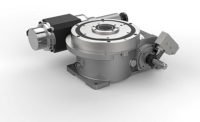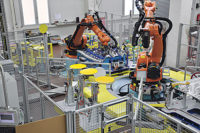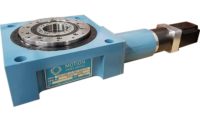BMW performs a lot of welding operations at its assembly plants, which are located throughout Europe and in South Carolina. Recently, the automaker hired The EDAG Group to develop a small-lot welding system for a European plant.
During system development, Manfred Hahl, managing director and COO of EDAG, researched several rotary indexing tables, but learned that none were strong enough to bear 16 tons. So he reached out to automation specialist Weiss GmbH.
Weiss agreed to make a customized table based on the company’s servo-driven CR 2600 series. Developed within six months, the table has a 20-ton capacity. Its center opening is 2 meters in diameter, which is large enough to accommodate a welding robot with a 2.5-meter reach.
On the outer edge are four tooling sections, each of which weighs up to 4 tons and holds parts as they are welded. BMW uses two of the tooling sections to weld rear hatches and hoods.
Foerster Systems, a Salem, OH-based integrator, also likes servo-driven indexers. A couple years ago, the company designed a system that inspects cross holes formed in forged steel components. The system inspects 17 part sizes. It features an EZ Indexer from Centricity Corp.
The indexer transports components 45 degrees in 0.5 second, with a positioning accuracy of ±30 arc-seconds. Parts also receive eddy current testing to determine material hardness. The indexer’s compact design enabled tooling to be installed under the dial plate.
These two installations represent the growing popularity of servo-driven indexers, which offer greater programming flexibility than traditional cam-driven units. In recent years, suppliers have also introduced direct-drive rotary indexers, precision-link conveyors and flexible linear assembly systems. All of these innovations provide manufacturers with automated indexing systems that are reliable and repeatable.
Linear vs. Rotary
Choosing between linear and rotary indexers for an automated assembly application depends primarily on space availability on the plant floor. Most products assembled on rotary indexers are small, with each assembly process taking seconds, not minutes. Indexers typically range in size from 18 inches to 15 feet in diameter.
Assembly operations performed on indexers include pick-and-place, screwdriving, dispensing, crimping, pressing and ultrasonic welding. SCARA robots, machine-vision systems and electrical testing can also be incorporated into rotary indexing systems.
“System selection is not a formulaic process, but in general, rotary systems are best for simple assemblies of eight parts or less being completed on 12 to 16 stations,” explains Robert Zaruba, president of CDS Corp. “Thirty is about the maximum number of stations to have on a rotary system before it becomes extremely large and unwieldy.”
Linear indexing systems, by comparison, are better suited for complicated assemblies. This is why they are popular among medical-device and pharmaceutical manufacturers, which sometimes operate systems containing 80 or 90 stations. Zaruba says that manufacturers prefer linear systems for inspection and testing processes during assembly.
If the plant floor has narrow aisles, a linear system is a better fit. This type of system optimizes space by placing stations on both sides of the conveyor and allowing tooling in the center area. It is modular and easily expandable, like inserting leaves in a table, and it shuttles assemblies between stations within fractions of a second.
Manufacturers often initially use rotary systems because of a product’s simplicity or low volume. But over time, as the assembly process requires more steps or product volume increases, the company migrates to a linear system.
Innovative Indexers
Unlike cam-driven indexers, direct-drive rotary indexing tables operate predominantly without mechanics or gearboxes. The servomotor is connected directly to the load. Weiss’ TO1300 direct-drive table has only one bearing under load, virtually eliminating backlash. It has a 1,300-millimeter footprint and a maximum speed of 80 rpm.
The programmable table can accommodate an index increment of 45 degrees, an index time of 0.21 second and a dwell time of 0.29 second. It produces a maximum torque of 26,600 newton-meters and can accommodate a moment of inertia of 160 kilogram-meter-squared.
Netafim Ltd., a manufacturer of professional irrigation systems based in Tel Aviv, Israel, recently installed a TO750 direct-drive table with five pick-and-place units. The table features an indexing ring with a large inside diameter containing 16 processing stations. Bill Eppich, vice president of Weiss North America Inc., says the table’s four-track design beats at 75 cycles per minute and allows production of 300 irrigation components per minute.
Suppliers also continue to expand the capabilities of servo-driven indexers. For example, Centricity’s EZ servo indexers require no tuning and work directly with PLC or PC control systems. Center-driven (EZ2000) and open-center (EZ4000) geared indexers are also available with an external bearing set.
The indexers’ diameter ranges from 8 inches to more than 60 inches. Load capacities are 5,500 pounds (standard EZ2000), 6,500 pounds (standard EZ4000) or 42,000 pounds (external bearing units).
Easy to install, the indexers come standard with a digital AC servo controller, absolute position feedback and software for laptop control. Operating functions include continuous, reciprocating, clockwise and counterclockwise motion; one- to 63-stop indexing; variable move time; and variable move and dwell torque settings.
The ITP series of cam-driven indexers from CDS features two, four, six, eight, 10 or 12 fixed stations. All six models in the series (ITP75 to ITP450) provide indexing accuracy to ±0.0008 inch of the cam follower’s pitch radius. The low-profile indexers are 135 to 600 millimeters wide, with load capacities from 10 to 11,000 pounds.
Zaruba says that the indexers require no maintenance because they’re prefilled with synthetic lubricant. They are sealed with O-rings to prevent leakage during operation, regardless of orientation. Plus, the indexers’ solid roller cam-follower technology greatly increases load capacity and shock resistance for e-stops and machine overloads.
Introduced earlier this summer, DE-STA-CO's HDE mechanical and servo indexers are used by automakers, tier suppliers and electric-vehicle-battery manufacturers in high-volume applications. The indexers have a dynamic payload capacity from 15,000 to 60,000 kilograms. The indexers’ torque rating is 12,000 to 88,000 newton-meters.
A medium-duty series, the MDE, is 1 meter in diameter and designed for moderate-weight applications. Its payload capacity is 3,000 to 10,000 kilograms, with a torque rating of 3,500 to 15,000 newton-meters.
Both models allow cam followers to be replaced without removing any fixtures. To quicken installation and enhance flexibility, the indexers’ controller works with servo, AC or DC motors, and links to all major Ethernet protocols (ProfiNet, EtherCAT, Ethernet/IP and CANOpen).
Servos allow manufacturers to quickly change indexing duration, distance and direction. Moving the indexer clockwise and counterclockwise to complete two assembly processes greatly minimizes cycle time.
Ways to Convey
The most common type of linear indexing system is a precision-link conveyor powered by a cam- or servo-driven rotary indexer. This type of conveyor consists of machined plates, or pallets, that are linked together in a chain like tank treads. The chain rides in tracks between two large sprockets.
Roller bearings enable the plates to move smoothly along the tracks and to pivot as they move around the sprockets. Part fixtures are mounted directly to the plates, which are made of aluminum, steel or cast iron.
The IC80 Series of conveyors from Sankyo America Inc. are capable of 100 indexes per minute. Each model number [IC80-80, -120 and -160] indicates the conveyor’s pitch in millimeters. Available with a custom-length chassis, the conveyors feature four-needle bearing followers on the back of each link.
Rick Amendolea, president of Centricity, says the EZ Flex conveyor’s modular construction allows for the mounting of ancillary equipment on the sides of the center beam. Powered by the EZ indexer, this belted conveyor is highly repeatable and comes in standard lengths of 5 to 30 feet. Custom lengths are also available.
Belts come in various materials with bolt-on or welded-on tooling. Motion profiles include indexing, bidirectional, reciprocating, continuous and teach mode.
The TL, TSL and TLX (extra-wide) conveyors from CDS come in carousel or over-under configurations, in lengths from 2 to 30 feet. Cycle rates of more than 240 indexes per minute are possible, with a minimum index-distance accuracy of ±0.0035 inch.
All series can be modified into Medi-Clean systems, in which the indexing drive is located within the machine. These systems can be used in clean rooms and feature nickel-plated components, internal Viton seals and O-rings, and FDA-approved lubricants applied to moving parts.
CAMCO Rite-Link conveyors have a slim and compact design with narrow links that accommodate oversized tooling. All three models (75RL, 115RL, 150RL) are maintenance-free and durable enough for harsh industrial applications. Link pitch ranges from 75 to 150 millimeters.
Also available from DE-STA-CO are 3- to 40-foot-long tabletop conveyors with a link pitch of 3, 4.5 or 6 inches. Their open modular frame design comes in 18-inch increments for quick assembly. It also allows easy pass-through of electric and air supply components.
Another type of linear system is the LS280, which combines the speed and precision of a rotary indexer with the flexibility of a linear asynchronous system. It consists of multiple independent locating stations connected by sections of hardened track. Assemblies move through the system on transporters that roll along the track.
The system’s modularity allows for an unlimited number of stations, each of which is decentralized from the others. Most importantly, the system is capable of four different processing times simultaneously. This is because each station can be equipped with cams having linear indexing pitches of 70, 140, 280 or 560 millimeters. Eppich says the system is popular with automotive, medical, consumer-product and battery manufacturers.








